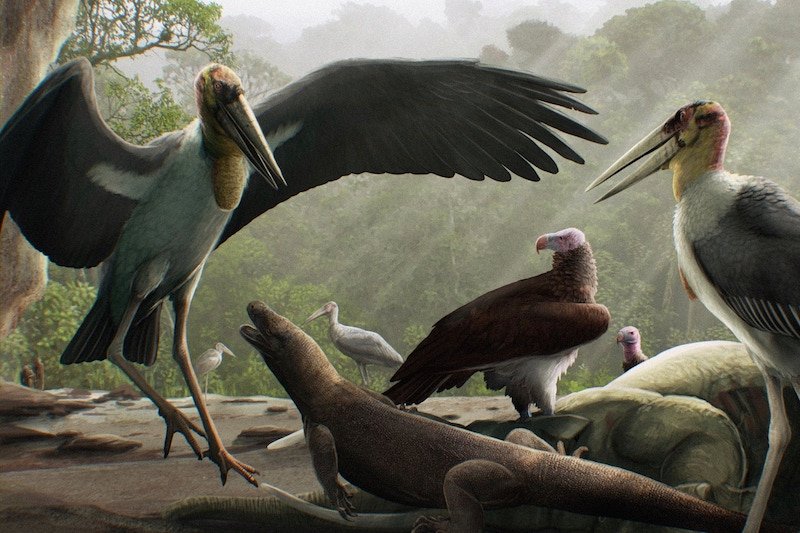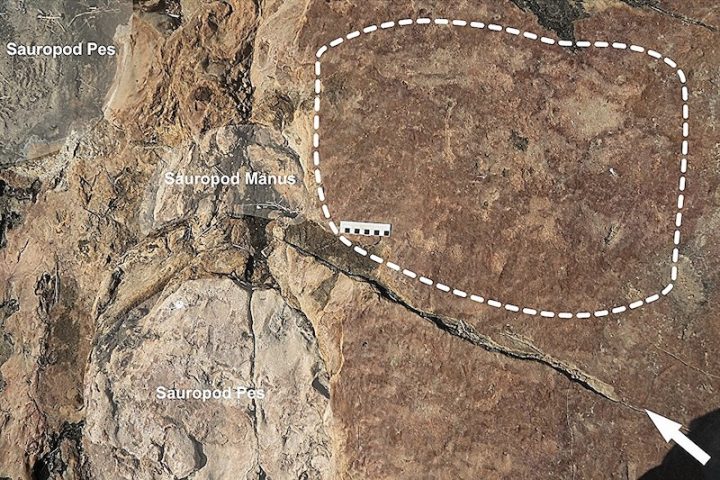More than 60,000 years ago, the island of Flores was home to a bird almost twice the size of tiny hominins.
On Flores, an island in eastern Indonesia, “hobbit” sized humans shared the natural environment with a gigantic bird. More than a meter long, the Ice Age stork Leptoptilos robustus towered over the 90 cm Homo floresiensis, which lived more than 60,000 years ago.
Paleontologists previously thought this large bird was a flightless species adapted to living in an isolated island ecosystem. But newly analyzed fossils, including wing bones presented in the journal Royal Society Open Science, have changed the story. Despite its gigantic size, this stork’s 3.6-meter wingspan probably allowed it to soar high above.
- Netherlands’ plan to put refugees on cruise ships sparks controversy
- The Weeping Philosopher Heraclitus
This new realization prompted paleontologists to revise what they previously thought about the anatomy and behavior of L. robustus. The new study suggests that the bird was probably a scavenger, like other prehistoric, flying storks known to have relied on herbivore carcasses rather than hunting small prey, just as the marabou storks of sub-Saharan Africa do today. The Flores stork’s preference for carrion may even explain why the animal went extinct.
In addition to the large birds, the island was home to a species of Stegodon, an extinct close relative of elephants that grew to just one meter tall. “Giant storks relied on them for a large part of their diet,” says University of Bergen paleontologist Hanneke Meijer, lead author of the new study. Meijer points out that Stegodon’s bones were found next to bird bones in a cave where birds would not dare to enter.
When Stegodon disappeared, Meijer and his colleagues suggest that L. robustus also disappeared. Other animals on the island that relied on mammals as a food source, such as Komodo dragons, have survived elsewhere. But the extinction of L. robustus coincided with major changes in Flores triggered by a period of warming near the end of the Ice Age. “Our hypothesis is that when Stegodon went extinct, the whole ecosystem collapsed,” says Meijer.
Paleontologists were able to create this new image of the giant Flores stork thanks to 21 bones, including wing fragments, found in Liang Bua cave. This rocky shelter could have been one of the places animals like Stegodon found to escape the heat and grab a drink – but carnivores may have taken advantage of the situation to grab an easy meal.
The remains of prey killed by a Komodo dragon or Homo floresiensis could have been a tempting snack for scavenging storks, which could then have died inside the cave and been buried there. This is how they may have been preserved in the fossil record until scientists excavated tens of thousands of bones years later.

Island evolution
Islands can be intense natural laboratories for evolution. The relative isolation can lead organisms to adapt in very different ways from those in the larger areas of Earth’s continents. For example, according to a phenomenon called the island rule, large species often shrink to get by on more limited resources, while usually small animals like rodents and lizards grow to unprecedented sizes.
When first described in 2010, the Flores stork was thought to be part of this pattern. The bird was initially thought to be a unique, flightless giant adapted to stalking smaller prey in the island’s forests. But the new study reveals that the Flores stork can fly, suggesting that the animal is probably not an unusual case of island evolution, but part of a family of giant storks that once soared over much of the globe.
“I think my perception of L. robustus has changed a lot over the course of my career,” says Meijer, who has studied some of the first specimens of the giant bird. He says the original set of bones was large and bizarre, apparently in keeping with the idea that island life changes creatures in unexpected ways.
But the discovery of the animal’s wing bones painted a different picture.
A giant in the sky
Liang Bua cave preserves a treasure trove of paleontological and archaeological specimens, including the remains of Homo floresiensis and Homo sapiens, stone tools used by both species and a collection of animal bones.
The bones of L. robustus were first discovered in 2004, but it took many years for experts to collect and catalog more remains from the animal. In their new study, Meijer and his colleagues put all the pieces together to create a more complete picture of the animal.
If the Flores stork could not fly, the bird’s wing bones would have been smaller and would have shown anatomical signs indicating they were no longer used for flight. Paleontologists have repeatedly observed this among the extinct, carnivorous “terror birds”, emus and their relatives and various other land birds that evolved after the extinction of the dinosaurs 66 million years later.
When the wing bones of Flores storks were identified in the collection at Liang Bua cave, “they looked like functional wing bones and nothing like the bones of flightless species,” Meijer says. These finds inspired Meijer and his colleagues to rethink the life of the giant bird.
“You think about how they would behave and interact with other species in Liang Bua. It’s almost as if you know an animal on a personal level. Every piece of skeleton that comes out of the cave completes another piece of the puzzle.”
“The new analysis shows that our understanding of the fossil record is constantly evolving, and that our initial interpretations of a fossil animal’s anatomy and behavior are preliminary hypotheses that are subject to re-evaluation,” says University of Cambridge paleontologist Daniel Field, who was not involved in the study. Such revisions not only help paleontologists better understand how and why species evolved, but also provide new insights into an organism’s extinction.
For example, by examining the distribution of giant storks in prehistoric Africa and Eurasia, the new study also reveals that L. robustus was one of the last surviving species of these once-abundant birds. Taking refuge on an island between the Indian and Pacific Oceans, the giant birds eventually died out, but left clues to their story on the cave floor of Liang Bua.
Meijer, H. J., Sutikna, T., Wahyu Saptomo, E., & Tocheri, M. W. (2022). More bones of Leptoptilos robustus from Flores reveal new insights into giant marabou stork paleobiology and biogeography. Royal Society Open Science, 9(7), 220435.




